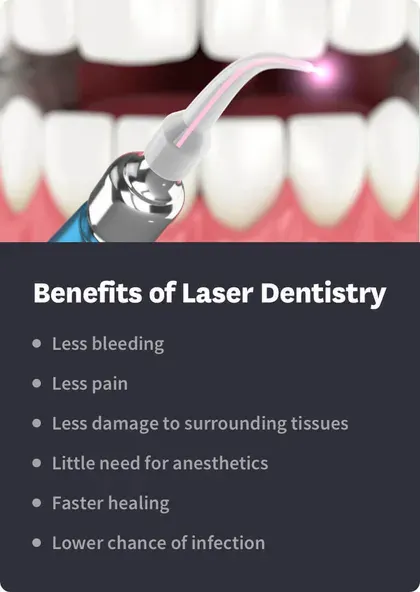What Is Laser Dentistry? Procedures, Risks, Benefits, Costs & More

Table of Contents
- What is Laser Dentistry?
- Types of Procedures
- Is It Safe?
- Benefits
- Disadvantages
- Costs
- Is It Covered by Insurance?
- References
Laser dentistry utilizes concentrated beams of light instead of a dental drill to cut oral tissues. It offers a cleaner, more precise way to treat common oral health problems like cavities and periodontal disease. Some of its many benefits include less pain, less anxiety and a lower chance of infection at the surgical site.
Laser dentistry does have several significant drawbacks, including a high cost, lack of insurance coverage and limited usefulness when used on teeth. If you’re interested in undergoing laser dentistry, you will need to carefully weigh the pros and cons that apply to your case.
What is Laser Dentistry?
Laser dentistry is the process of using laser beams (beams of concentrated light) to perform dental procedures. When this beam is directed at a patient’s gums or teeth, it is absorbed by that surface. The energy in the light then destroys the tissue at that site.
Dentists set their lasers to specific wavelengths so that they can target particular tissues. Targeting allows them to control the laser's effects and ensure that it only works on tissues the dentist wants to remove.
Many dentists who incorporate laser dentistry into their practice receive special training from institutions like the Academy of Laser Dentistry. They learn specific techniques to help them use dental lasers as safely and effectively as possible. However, dentists can offer laser dentistry to their patients even if they have not undergone this training.
Types of Laser Dentistry Procedures
Dentists employ lasers to work on hard tissue (teeth and bones) and soft tissue (gums). They can’t use the same laser for both kinds of tissues, and manufacturers make different types of lasers for various procedures. Because soft tissue lasers are less expensive and easier to use, soft tissue laser dentistry procedures are much more common.
All of the laser procedures work as well as traditional techniques that use a dental drill.
Examples of soft-tissue procedures are:
Treatments for periodontal disease, including Laser-Assisted New Attachment Procedure (LANAP)
Gingivectomy or gum contouring (cutting away some gum tissue to create an attractive shape that reveals more of the tooth)
Removal of tumors or lesions
Frenectomy (cutting through the connective tissue between your lips and gums)
Examples of hard-tissue procedures include:
Cavity treatment
Root canal therapy
Osteotomy (removing part of the jawbone)
Dental lasers have proven very effective for medically important dental procedures, but they also work well for cosmetic or health maintenance dental procedures.
Here are some other laser procedures you might encounter:
Removing small amounts of tooth enamel or reshaping fillings
Preparing tooth enamel for composite bonding, veneers, or similar procedures
Repairing old fillings
Removing inflamed gum tissue
Accelerating the effects of whitening procedures
Detecting cavities or areas of thinner enamel
Viewing within layers of soft tissue without exposing you to radiation from x-rays
Treating cold sores
Regenerating nerves and damaged blood vessels
Reducing scar tissue
Treating TMJ pain by reducing inflammation
Treating obstructive sleep apnea by reshaping sections of the throat
Is It Safe?
Laser dentistry is considered safe, and some dentists consider it safer than traditional manual methods because it is less messy and offers more precise control. The FDA approved lasers for dental surgical use in 1997.
However, there are some risks associated with laser dentistry that you should be aware of. Risks depend on the exact procedure and what tissues are affected. Potential issues include:
Damage to the gum tissue around the surgical area
Damage to the pulp of your tooth
Damage to your eyes from looking directly at the laser beam
Proper safety precautions can minimize the risks of laser dentistry. Laser equipment must be tested regularly to ensure it is working as intended.
In addition, everyone who will be in the room during a laser dentistry procedure must wear protective eyewear to shield their eyes against the intense light that the laser produces. Anyone who visits the office with the patient, such as parents accompanying their young children to their dental appointments, must wear protective shields.
Benefits of Laser Dentistry

There are many reasons to consider getting laser dentistry instead of typical dentistry. Patients who choose laser dentistry typically experience:
Less bleeding
Less pain
Less damage to surrounding tissues
Little need for local anesthetics
Faster healing
Lower chance of infection
Many patients also find laser dentistry much less anxiety-inducing because there are no alarming sounds or smells to contend with while they are in the chair. Because most patients do not require local anesthetic for laser dental procedures, they may also be able to receive treatment without getting any needles in their mouth.
Both benefits help dentists who treat young patients or any patients who harbor a fear of dental procedures.
Disadvantages of Laser Dentistry
There are a few significant downsides to laser dentistry, which may explain why it hasn’t become more popular. The technique cannot be used:
On teeth that already have fillings in them
On the spaces between teeth
To prepare teeth for a crown or bridge
Most of the work that dentists do on teeth involves at least one of these three things. This means that traditional drilling is the only option for most hard tissue dental procedures.
Costs
Because many dentists do not offer laser dentistry, it is difficult to estimate exactly how much it will cost you to have this kind of dental work done.
However, it is important to note that laser dentistry requires a significant investment from dentists. The cost of a single dental laser ranges from around $500 to more than $100,000. In contrast, the equipment used in traditional dentistry costs a fraction of that price: typically just a few hundred dollars.
This difference in equipment costs has led most dentist to charge a little more for laser dentistry services than conventional ones. For instance, gum contouring usually costs between $50 and $350 per tooth. Contouring done using manual methods will usually fall on the lower end of that range, while laser contouring will cost more.
If you are interested in laser dentistry but have a limited budget, shop around. You may be able to find several dentists offering this type of treatment in your area. Ask them about their pricing and any discounts or payment plans they might be willing to offer. This is not a guaranteed way to get lower prices, but if getting laser treatment really matters to you, it may be worth a try.
Is Laser Dentistry Covered by Insurance?
Laser dentistry is sometimes covered by insurance, but not always. When it is covered, your insurance may only pay for a portion of your total expenses.
Part of the reason why insurance coverage for laser dentistry is inconsistent is that it is not fully recognized within coding frameworks. Some specific billing codes for laser dentistry procedures do exist, but they do not cover all the ways in which laser dentistry is typically used. Some practitioners choose to bill for laser therapies under miscellaneous codes, while others simply use standard codes for procedures like gum contouring.
If cost is a concern for you, ask your dentist about how they typically bill for laser dentistry procedures. This will let you know what to look for in your insurance coverage when budgeting for the cost of your treatment.
If the procedure you choose is not considered cosmetic, you may also be able to pay for your laser dentistry with funds from your HSA or FSA. If you aren't sure if your procedure qualifies, ask your plan administrator for clarification.
